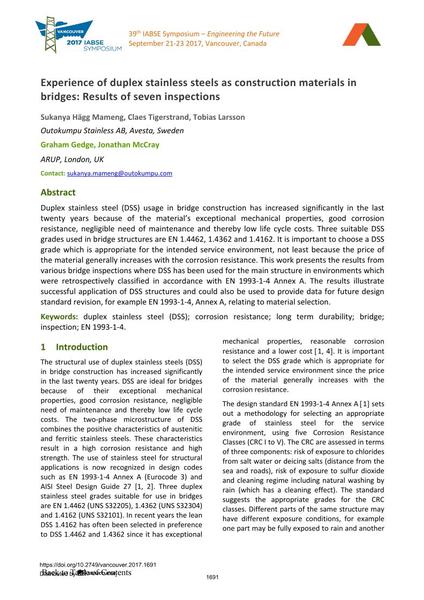Experience of duplex stainless steels as construction materials in bridges: Results of seven inspections

|
|
|||||||||||
Détails bibliographiques
| Auteur(s): |
Sukanya Häg Mameng
(Outokumpu Stainless AB, Avesta, Sweden)
Claes Tigerstrand (Outokumpu Stainless AB, Avesta, Sweden) Tobias Larsson (Outokumpu Stainless AB, Avesta, Sweden) Grahamn Gedge (ARUP, London, UK) Jonathan McCray (ARUP, London, UK) |
||||
|---|---|---|---|---|---|
| Médium: | papier de conférence | ||||
| Langue(s): | anglais | ||||
| Conférence: | IABSE Symposium: Engineering the Future, Vancouver, Canada, 21-23 September 2017 | ||||
| Publié dans: | IABSE Symposium Vancouver 2017 | ||||
|
|||||
| Page(s): | 1691-1698 | ||||
| Nombre total de pages (du PDF): | 8 | ||||
| Année: | 2017 | ||||
| DOI: | 10.2749/vancouver.2017.1691 | ||||
| Abstrait: |
Duplex stainless steel (DSS) usage in bridge construction has increased significantly in the last twenty years because of the material’s exceptional mechanical properties, good corrosion resistance, negligible need of maintenance and thereby low life cycle costs. Three suitable DSS grades used in bridge structures are EN 1.4462, 1.4362 and 1.4162. It is important to choose a DSS grade which is appropriate for the intended service environment, not least because the price of the material generally increases with the corrosion resistance. This work presents the results from various bridge inspections where DSS has been used for the main structure in environments which were retrospectively classified in accordance with EN 1993-1-4 Annex A. The results illustrate successful application of DSS structures and could also be used to provide data for future design standard revision, for example EN 1993-1-4, Annex A, relating to material selection. |
||||
| Mots-clé: |
pont
|
||||

